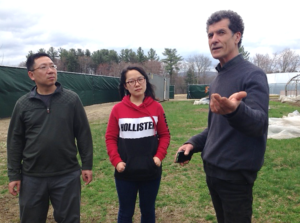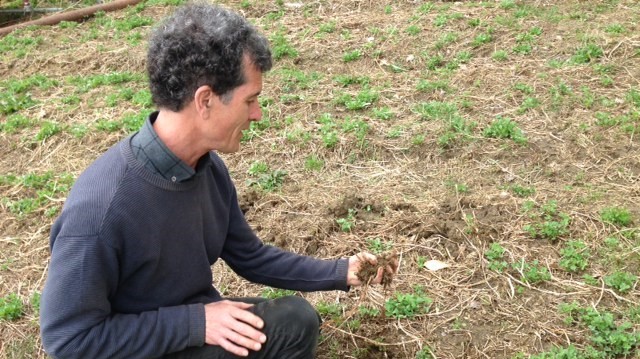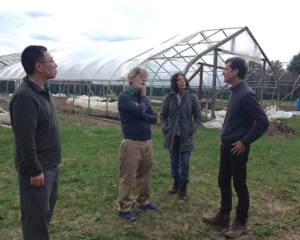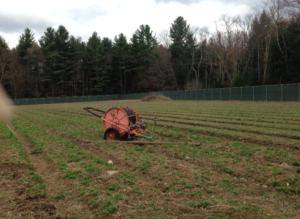Cannabis to the Rescue: Flowering Herb Offers Effective, Economic Means of Capturing CO2
Equinox Farm’s Ted Dobson showing the soil where cannabis will be grown.
Cannabis may very well be the ‘drug of choice’ in terms of organically sequestering atmospheric carbon dioxide through agricultural production, aided by the highly-effective, natural solution that is rock dust remineralization.
“I’ve been fascinated with remineralizing for decades,” says Ted Dobson, general manager and farmer-in-chief at Equinox Farm near Berkshire Hills, Massachusetts. With the help of some rock dust, the New England horticulturalist sees cannabis farming as producing a rich commodity that also puts excess CO2 in its proper place — underground.
“What I want is to grow big, healthy plants with large, healthy root systems, and I do think we’re going to see hemp become an economic engine all over the planet.”
According to Dobson, the size of a cannabis plant correlates to the fertility it receives through such things as rock dust application. He plans to grow these plants for up to six months, which is enough time for each plant to develop a root system equivalent to a five-year-old tree.
“That’s extraordinary carbon sequestration. That’s extraordinary photosynthesis in one season from a plant that has the ability to be between 10 and 15 feet tall and three to four feet wide, bearing three to six pounds [of production] per plant at a retail value of thousands of dollars per pound.”
Of course, the monetary value of this crop type not only comes from the psychedelic, intoxicating and medicinal qualities associated with cannabinoids THC and CBD in marijuana. For its part, industrial hemp (a strain of cannabis) is rich in nutrients and strong enough for a variety of applications, including as construction materials.

Dobson discusses the project with researchers Dr. Jim Tang and his assistant Yujie Hua from Marine Biological Laboratory in Woods Hole.
“When the first white colonists came to Massachusetts in 1604, they came with hempseed,” Dobson says, adding 17th Century transportation systems were based on shipping between England and other European ports. Ships’ sails were hemp-based for durability. More importantly, all ropes on these ships were made of long-lasting hemp.
“[Hemp] is like a lumber material, but the tensile strength of a single fibre of hemp is up there with any synthetic material on the planet. Anything we make out of plastic, anything we make out of gutting a tree, can be made out of hemp fibre, pulp or some combination of the two.”
Working with Remineralize the Earth, Dobson aims to prove cannabis is ideal for industrial-scale agricultural development, due to its impressive monetary worth and the fact it can sequester substantial amounts of atmospheric CO2, compounded when farmers leave the root systems underground post-harvest.
He says: “All I’m adding to the conversation is a bigger, better root system.”
Take it outside: Why marijuana factories miss plant’s potential
Equinox Farm is the first business in Massachusetts to get a cannabis-growing licence to demonstrate the viability of growing the plant outside rather than in a factory. Dobson sees outdoor cannabis crops as imperative to maximizing the ecological value.
“So many big, corporate, monetized entities are growing indoors,” he says. “They use artificial fertilizer. They’re doing harm to the soil and harm to the plant’s potential. They’re wasting an incredible opportunity to make a biological cycle with this plant and build soil while doing it, while also getting the economic value.”
Marijuana factories are popping up throughout the world, suggests Dobson, and he remains “dead set against” this industrial practice. “It’s an abnegation of the goodness this plant brings to the soil. We have the agricultural potential to grow this plant in such a way that it’s a net benefit, rather than just lining people’s pockets.”
Dobson’s point: Growing marijuana and hemp outside uses the sun and soil, and thus requires fewer human inputs and less energy. He is confident growing cannabis outside works, as people have done so for millennia. “Even though it’s just on this tiny, little plot, I can still potentially harvest thousands and thousands of pounds if I do my job well.”
He adds: “I’m hoping the rock dust can make a difference.”
Remineralization: A long journey to acceptance
Why is the adoption pace so slow for more natural agricultural methods such as rock dust remineralization? When it comes to New England dairy farmers, notes Dobson, the reason is simple: Chemical fertilizers already are proven to work on their pastures. As such, promoting more organic alternatives takes time, decades in fact.
“People don’t understand that New England was a rundown agricultural entity by the turn of the 20th Century,” he says, adding chemical fertilizers became the “absolute miracle drug” for generations of farmers understandably latching onto this one solution. With NPK-soluble fertilizers in the early 1900s, rundown New England soils, which previously could not grow even proper cattle feed, suddenly could grow high-yielding corn crops.
“[These farmers] are survivors, but they’re trained to use chemistry because it worked for their fathers and grandfathers, and most importantly for their great-grandfathers.”
By the time Dobson entered the industry in the late 1970s, organic agricultural practices were barely understood, and finding farmers willing to implement ‘alternative’ theories was next to impossible. Fortunately, he says, organic farming has progressed “light years” since then. “Forty years ago, there wasn’t the sophistication, there wasn’t the science, there wasn’t the data, and there wasn’t the research that we have today.”
According to esteemed biochemist and Remineralize the Earth board director Dr. Thomas J. Goreau, almost any soil will benefit from applying rock dust, as almost all soils have nutritional needs that remineralization can help satiate.
“Every soil has nutrient limitations of some kind or another,” he says. “It’s different for each one depending on geological origin and history of soil use. That means, ideally, you should tailor rock powder to the needs of your soil.”
Applying rock dust could be a key strategy for the future of cannabis and its crucial climate mitigation properties. That is why Remineralize the Earth is pleased to be a partner on this project.
Carter Haydu is a writer, reporter, and journalist based in Alberta and Saskatchewan. He works for JuneWarren-Nickle’s Energy Group, with regular articles appearing in the Daily Oil Bulletin. He is a freelance columnist with the award-winning Quad Town Forum weekly newspaper, based in Vibank, Saskatchewan. He also contributes content for a series of magazines in and around Regina and Saskatoon. He received a BA in Political Science and Philosophy from Augustana University College in 2001 and a diploma in journalism from Grant Macewan College in 2005.
Support us on Patreon
Thank you for joining us today! Please become a member of RTE and support us on Patreon. Unlike many larger organizations, we work with a team of determined and passionate volunteers to get our message out. We aim to continue to increase the awareness of remineralization to initiate projects across the globe that remineralize soils, grow nutrient dense food, regenerate our forests’ and stabilize the climate – with your help! If you can, please support us on a monthly basis from just $2, rest assured that you are making a big impact every single month in support of our mission. Thank you!










Got something to say?